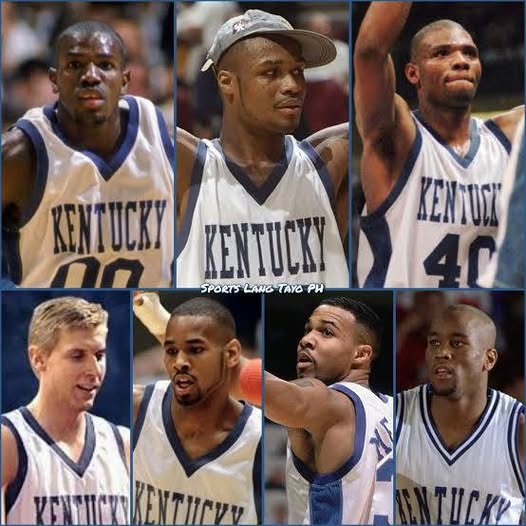The 1996 Kentucky Wildcats Had One of the Most Talented Rosters in NCAA History — But Here’s the Real Reason They Couldn’t Keep Winning
In the pantheon of college basketball greatness, few teams have captivated fans, analysts, and historians quite like the 1995–1996 Kentucky Wildcats. Coached by the relentless and forward-thinking Rick Pitino, this squad wasn’t just good — they were dominant. Finishing the season with a staggering 34–2 record and rolling through the NCAA tournament, culminating in a national title, the ’96 Wildcats are often regarded as one of the most talent-rich college basketball teams ever assembled. Their roster boasted nine future NBA players, several of whom would go on to have long, impactful professional careers. Names like Antoine Walker, Tony Delk, Derek Anderson, Ron Mercer, Nazr Mohammed, Walter McCarty, and Jamaal Magloire give a sense of the depth and sheer talent this team carried.
Yet for all their brilliance, Kentucky’s golden era under Pitino didn’t evolve into a sustained dynasty. Yes, the program remained competitive and even captured another national title in 1998 under Tubby Smith with many holdovers from the 1996 team. But the 1996 Wildcats themselves did not return to win back-to-back championships, nor did the nucleus stay intact long enough to build a true dynasty in the way that UCLA in the 1960s and early ’70s or Duke in the early ’90s managed. The question has lingered ever since: how could a team this loaded not dominate for longer? The truth lies less in talent and more in timing, personality, and the shifting nature of college basketball.
To understand the 1996 Wildcats’ meteoric rise and rapid dispersal, one must first understand the context in which they operated. The mid-1990s marked a turning point in college basketball — an era when the very concept of a “dynasty” was being redefined by new rules, changing attitudes, and the growing gravitational pull of the NBA. For the Wildcats, this meant that keeping talent together was not only difficult — it was almost impossible.
The team’s staggering depth was both its greatest strength and, in the long run, its most destabilizing factor. Most elite college basketball teams depend heavily on five or six key contributors. Kentucky’s 1996 team had as many as ten players who could credibly start at almost any other Division I program. Pitino’s “platoon” system — essentially running two starting lineups — allowed him to keep pressure on opponents while managing minutes and maintaining morale. It worked, largely because the team bought into the collective mission of winning a championship. But that kind of harmony is hard to sustain when future NBA stars are jostling for exposure and draft positioning.
Tony Delk, the team’s leading scorer and Most Outstanding Player of the Final Four, was a senior in 1996 and moved on to the NBA. Walter McCarty and Mark Pope, two other veteran contributors, also graduated. But the bigger losses came from underclassmen. Antoine Walker, just a sophomore, declared for the NBA Draft after the championship run and was selected sixth overall. That move, while not entirely unexpected, signaled a shift. As early-entry declarations became more common, Kentucky’s deep bench began to function as a springboard rather than a foundation.
Derek Anderson and Ron Mercer, two electric underclassmen, returned in 1996–97, but the dynamic had already changed. There was no longer the same senior leadership at the top. Meanwhile, Jamaal Magloire and Nazr Mohammed, talented big men who had served as role players during the championship season, were still developing. The loss of experience at the top and the influx of players with NBA aspirations meant that Pitino faced a constant churn of roster turnover. Even as he continued to recruit top talent, the cohesion that made the 1996 team special began to dissipate.
Another key factor in the team’s inability to extend their dominance was Rick Pitino himself. The architect of the 1996 Wildcats, Pitino was a master strategist known for his pressing defense, up-tempo offense, and NBA-caliber conditioning. His system relied not just on talent but on buy-in — players needed to accept roles, sacrifice minutes, and believe in the greater goal. Pitino had the charisma and authority to enforce that culture, but he was also eyeing a return to the NBA. After the 1996–97 season, Pitino left Kentucky to coach the Boston Celtics, and while Tubby Smith would admirably carry the program forward, it was clear that something fundamental had changed.
Pitino’s departure was emblematic of the broader shift occurring in college basketball. Coaches and players alike were being drawn to the NBA at unprecedented rates. The allure of professional money, fame, and competition was simply too strong, especially for players who had already proven themselves on the biggest college stage. Kentucky had become a victim of its own success — it was now a proving ground, not a proving point.
The nature of college basketball itself was changing. The introduction of the NBA’s early-entry rules and the growing dominance of agents and scouts in player development meant that top-tier programs like Kentucky were increasingly serving as one-year or two-year pit stops. Unlike the teams of previous decades, which could keep a core group together for three or four years, the Wildcats were constantly rebuilding, reloading, and readjusting.
Even so, the talent pipeline did not dry up. Kentucky remained a recruiting juggernaut, and many of the players from the 1996 team continued to make headlines, both in college and in the NBA. The 1997 team returned to the national title game but fell short in overtime against Arizona. In 1998, under Tubby Smith, the Wildcats captured another national championship — a testament to the program’s resilience and depth. But by then, the identity of the team had changed. The electrifying style of play, the deep rotation, the swagger and star power that defined the 1996 group — it had evolved into something else. Effective, yes. Historic? Not in the same way.
So while the 1996 Wildcats earned their place in the record books as one of the greatest teams of all time, they were also a product of a unique moment in college basketball history — a moment that could not be sustained. Their talent was undeniable, their dominance unquestionable. But their time together was fleeting. It wasn’t failure that ended their run — it was evolution.
The landscape of college basketball in the mid-1990s no longer supported dynasties in the traditional sense. The Wildcats were a brilliant supernova — burning brightly, brilliantly, and briefly. Their inability to keep winning wasn’t a reflection of flaws in their game or breakdowns in chemistry; rather, it was the result of a system that was rapidly changing beneath their feet. The same forces that brought them together — early recruitment, national scouting, NBA-caliber coaching — were the very forces that pulled them apart.
In retrospect, that may be why the 1996 Kentucky Wildcats still hold such a special place in the hearts of fans. They weren’t just dominant — they were rare. In today’s world of one-and-done players, NIL deals, and constant transfer portal movement, it’s almost impossible to imagine assembling such a deep, talented, and unselfish team again. Their season stands as a monument to what is possible when everything clicks — talent, coaching, chemistry, and timing — even if only for one shining season.
And maybe that’s the point. Maybe greatness in college basketball isn’t meant to be measured by longevity but by moments. The 1996 Wildcats gave us one of the greatest in the sport’s history. That they didn’t keep winning only underscores just how special that moment truly was.



